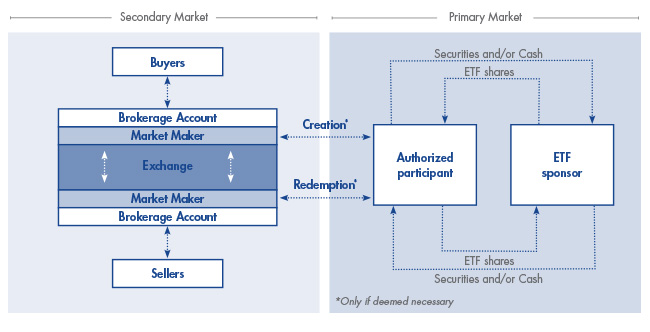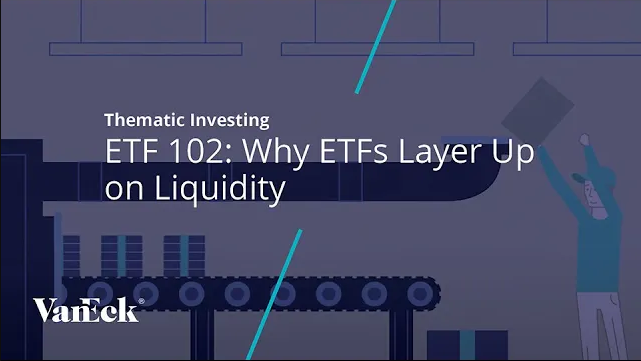ETF 102: The Inner Workings of ETF Creations and Redemptions
August 15, 2019
Read Time 3 MIN
The creation and redemption process is a fundamental feature of the ETF structure. Learn how this process works and its role in driving liquidity and tax efficiency for investors.
ETF 101: Understanding the Basics
ETF 102: The Inner Workings of ETF Creations and Redemptions
ETF 103: Is This ETF Right for Your Portfolio?
ETF 104: Getting the Most Out of Your ETF Trades
ETF 105: Gaining Efficient Access to Bond Markets with Fixed Income ETFs
ETF 106: Debunking Fixed Income Myths
ETF 107: Passive vs. Active ETFs Explained
Setting the Stage
As a starting point, let’s discuss the differences between the secondary and primary markets for ETF shares.
The secondary market, which includes the widely recognized securities exchanges, is where investors buy and sell existing shares of ETFs. For example, if you wish to buy 2,000 shares of an ETF, you typically place an order with a financial advisor and purchase those shares at market price from other sellers in the secondary market.
The primary market refers to where ETF share creations and redemptions take place in large specified units of 50,000 shares or multiples thereof. It provides an additional “layer”, or source, of liquidity that can be accessed for large orders or when demand exceeds supply, or vice versa, on the secondary market. Typically, large financial institutions, authorized participants, and market makers1 transact in the primary market. Market makers buy and sell ETF shares in the secondary market to provide liquidity and may also serve as authorized participants.
Authorized Participants
Authorized participants (APs) are an important part of the creation and redemption process. Usually large broker-dealers or custodial institutions that have executed an agreement with the issuer, APs are the only entities that may transact directly with the ETF issuer, and as such, play a critical role in helping ensure fair pricing and ETF liquidity. When the secondary market price of an ETF falls out of line with its net asset value (NAV)2, an AP may create or redeem shares of the ETF, bringing prices back in line with the NAV.
Carefully Crafted Creations
When there are not enough ETF shares available on the secondary market to satisfy demand, an ETF may begin trading at a premium (its current market price is higher than its NAV). When this happens, an AP may step in and create new shares.
To create new passively managed ETF shares, the AP generally acquires shares in all of the underlying securities that compose the ETF, in the same proportions as the fund’s index. On the primary market, the AP then delivers this basket of securities to the ETF issuer, and in exchange, receives shares of the ETF in blocks known as creation units3. The AP then sells these ETF shares in the secondary market. The additional supply of shares tends to bring the ETF’s price back in line with its NAV.
Road to Redemptions
The process described above also works in reverse when demand is low. For example, let us imagine that an ETF begins trading at a discount (its current market price is lower than its NAV). The AP leaps into action, buying up 50,000 shares of the discounted ETF on the secondary market and tendering these shares to the issuer for shares of the ETF’s underlying securities.
Redemptions reduce the number of ETF shares available on the secondary market. As a result, the discount shrinks or disappears as the ETF share price moves closer in line with its NAV.

A Tax Efficient Edge
When ETF shares are redeemed by the AP, they are typically tendered in kind to the ETF issuer. The ETF issuer is not selling any securities in this transaction, so the exchange is not viewed by the IRS as a taxable event. This allows ETF issuers to reduce what could otherwise be substantial capital gains taxes. The cost savings helps keep expenses low for end investors, and contributes to the well-known tax efficiency of the ETF structure.
A note on mutual funds: When mutual fund shares are redeemed by investors, the issuer must sell the underlying securities to raise cash—a taxable event which can impact performance and trigger a capital event which can have tax implications for the remaining mutual fund shareholders.
Sources of Liquidity
So, there are actually two primary sources of ETF liquidity: the secondary or open market, consisting of shares bought and sold throughout the day, and the primary market managed by APs. Most ETF investors rely on secondary market liquidity.
Primary market liquidity draws on the liquidity of the underlying securities comprising the ETF. Very large trades can tap into the deeper liquidity source of the primary market, where large blocks of ETF shares can be either created or redeemed.
In Summary
Creations and redemptions are critical to the structure and liquidity of ETFs, as well as key drivers of ETF tax efficiency. Through these twin mechanisms, the supply of ETF shares in the open market can be brought in line with demand, thus fairly pricing ETFs.
IMPORTANT DISCLOSURES
1 Market makers: Specialized traders who seek liquidity for a set of securities on an exchange.
2 Net Asset Value (NAV): The total value per share of an ETF’s underlying securities, less its liabilities.
3 Creation unit: Large blocks of ETF shares created by ETF issuers. Creation unit sizes can vary by issuer and fund, but usually consist of 50,000 shares or multiples thereof.
This is not an offer to buy or sell, or a solicitation of any offer to buy or sell any of the securities mentioned herein. The information presented does not involve the rendering of personalized investment, financial, legal, or tax advice. Certain statements contained herein may constitute projections, forecasts and other forward looking statements, which do not reflect actual results, are valid as of the date of this communication and subject to change without notice. Information provided by third party sources are believed to be reliable and have not been independently verified for accuracy or completeness and cannot be guaranteed. The information herein represents the opinion of the author(s), but not necessarily those of VanEck.
Past performance is not a guarantee of future results. Performance may be lower or higher than performance data quoted. Please visit vaneck.com for performance current to the most recent month end.
Diversification does not assure profit nor protect against loss.
The "Net Asset Value" (NAV) of a VanEck Exchange Traded Fund (ETF) is determined at the close of each business day, and represents the dollar value of one share of the fund; it is calculated by taking the total assets of the fund, subtracting total liabilities, and dividing by the total number of shares outstanding. The NAV is not necessarily the same as the ETF's intraday trading value. VanEck ETF investors should not expect to buy or sell shares at NAV.
ETF Fund shares are not individually redeemable and will be issued and redeemed at their net asset value (NAV) only through certain authorized broker-dealers in large, specified blocks of shares called "creation units" and otherwise can be bought and sold only through exchange trading. Shares may trade at a premium or discount to their NAV in the secondary market. You will incur brokerage expenses when trading Fund shares in the secondary market.
Investing involves substantial risk and high volatility, including possible loss of principal. Bonds and bond funds will decrease in value as interest rates rise. An investor should consider the investment objective, risks, charges and expenses of the Fund carefully before investing. To obtain a prospectus and summary prospectus, which contains this and other information, call 800.826.2333 or visit vaneck.com. Please read the prospectus and summary prospectus carefully before investing.
Related Insights
March 23, 2020
September 27, 2019
Execute ETF trades as cost efficiently as possible by sticking to these important trading best practices.
September 13, 2019
September 03, 2019
Related Funds
IMPORTANT DISCLOSURES
1 Market makers: Specialized traders who seek liquidity for a set of securities on an exchange.
2 Net Asset Value (NAV): The total value per share of an ETF’s underlying securities, less its liabilities.
3 Creation unit: Large blocks of ETF shares created by ETF issuers. Creation unit sizes can vary by issuer and fund, but usually consist of 50,000 shares or multiples thereof.
This is not an offer to buy or sell, or a solicitation of any offer to buy or sell any of the securities mentioned herein. The information presented does not involve the rendering of personalized investment, financial, legal, or tax advice. Certain statements contained herein may constitute projections, forecasts and other forward looking statements, which do not reflect actual results, are valid as of the date of this communication and subject to change without notice. Information provided by third party sources are believed to be reliable and have not been independently verified for accuracy or completeness and cannot be guaranteed. The information herein represents the opinion of the author(s), but not necessarily those of VanEck.
Past performance is not a guarantee of future results. Performance may be lower or higher than performance data quoted. Please visit vaneck.com for performance current to the most recent month end.
Diversification does not assure profit nor protect against loss.
The "Net Asset Value" (NAV) of a VanEck Exchange Traded Fund (ETF) is determined at the close of each business day, and represents the dollar value of one share of the fund; it is calculated by taking the total assets of the fund, subtracting total liabilities, and dividing by the total number of shares outstanding. The NAV is not necessarily the same as the ETF's intraday trading value. VanEck ETF investors should not expect to buy or sell shares at NAV.
ETF Fund shares are not individually redeemable and will be issued and redeemed at their net asset value (NAV) only through certain authorized broker-dealers in large, specified blocks of shares called "creation units" and otherwise can be bought and sold only through exchange trading. Shares may trade at a premium or discount to their NAV in the secondary market. You will incur brokerage expenses when trading Fund shares in the secondary market.
Investing involves substantial risk and high volatility, including possible loss of principal. Bonds and bond funds will decrease in value as interest rates rise. An investor should consider the investment objective, risks, charges and expenses of the Fund carefully before investing. To obtain a prospectus and summary prospectus, which contains this and other information, call 800.826.2333 or visit vaneck.com. Please read the prospectus and summary prospectus carefully before investing.
Related Insights
March 23, 2020
September 27, 2019
Execute ETF trades as cost efficiently as possible by sticking to these important trading best practices.
September 13, 2019
September 03, 2019

